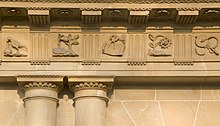| This article needs additional citations for verification. Please help improve this article by adding citations to reliable sources. Unsourced material may be challenged and removed. Find sources: "Frieze" – news · newspapers · books · scholar · JSTOR (January 2025) (Learn how and when to remove this message) |




In classical architecture, the frieze /friːz/ is the wide central section of an entablature and may be plain in the Ionic or Doric order, or decorated with bas-reliefs. Paterae are also usually used to decorate friezes. Even when neither columns nor pilasters are expressed, on an astylar wall it lies upon the architrave ("main beam") and is capped by the moldings of the cornice. A frieze can be found on many Greek and Roman buildings, the Parthenon Frieze being the most famous, and perhaps the most elaborate.
In interiors, the frieze of a room is the section of wall above the picture rail and under the crown moldings or cornice. By extension, a frieze is a long stretch of painted, sculpted or even calligraphic decoration in such a position, normally above eye-level. Frieze decorations may depict scenes in a sequence of discrete panels. The material of which the frieze is made of may be plasterwork, carved wood or other decorative medium.
More loosely, "frieze" is sometimes used for any continuous horizontal strip of decoration on a wall, containing figurative or ornamental motifs. In an example of an architectural frieze on the façade of a building, the octagonal Tower of the Winds in the Roman agora at Athens bears relief sculptures of the eight winds on its frieze.
A pulvinated frieze (or pulvino) is convex in section. Such friezes were features of 17th-century Northern Mannerism, especially in subsidiary friezes, and much employed in interior architecture and in furniture.
The concept of a frieze has been generalized in the mathematical construction of frieze patterns.
Ancient examples
- Achaemenid friezes
-
 Achaemenid Lotus and Palmette scroll
Achaemenid Lotus and Palmette scroll
-
 Achaemenid frieze designs at Persepolis.
Achaemenid frieze designs at Persepolis.
- Greek friezes
-
 Ionic frieze of the Erechtheum (Athens), 421–406 BCE
Ionic frieze of the Erechtheum (Athens), 421–406 BCE
-
 Top: Kyanos frieze from Tiryns. Bottom: Frieze of the Erechtheion in (Athens), 4th BCE
Top: Kyanos frieze from Tiryns. Bottom: Frieze of the Erechtheion in (Athens), 4th BCE
-
 Frieze from Delphi incorporating lotuses with multiple calyxes
Frieze from Delphi incorporating lotuses with multiple calyxes
- Indian friezes
-
 Frieze of the lost capital of the Allahabad pillar, with two lotuses framing a "flame palmette" surrounded by small rosette flowers, 3rd BCE
Frieze of the lost capital of the Allahabad pillar, with two lotuses framing a "flame palmette" surrounded by small rosette flowers, 3rd BCE
-
 Rampurva bull capital, detail of the abacus, with two "flame palmettes" framing a lotus surrounded by small rosette flowers, 3rd BCE
Rampurva bull capital, detail of the abacus, with two "flame palmettes" framing a lotus surrounded by small rosette flowers, 3rd BCE
-
 Frieze of the Sankissa elephant, 3rd century BCE
Frieze of the Sankissa elephant, 3rd century BCE
References
- Senseney, John R. (2021-03-01). "The Architectural Origins of the Parthenon Frieze". Journal of the Society of Architectural Historians. 80 (1): 12–29. doi:10.1525/jsah.2021.80.1.12. ISSN 0037-9808.
- Cotterill, Henry Bernard (1913). Ancient Greece: A Sketch of Its Art, Literature & Philosophy Viewed in Connexion with Its External History from Earliest Times to the Age of Alexander the Great. George G. Harrap & Company.
- "Parthenon Frieze". www.mcah.columbia.edu. Retrieved May 7, 2017.
External links
- "Frieze" . Encyclopædia Britannica (11th ed.). 1911.